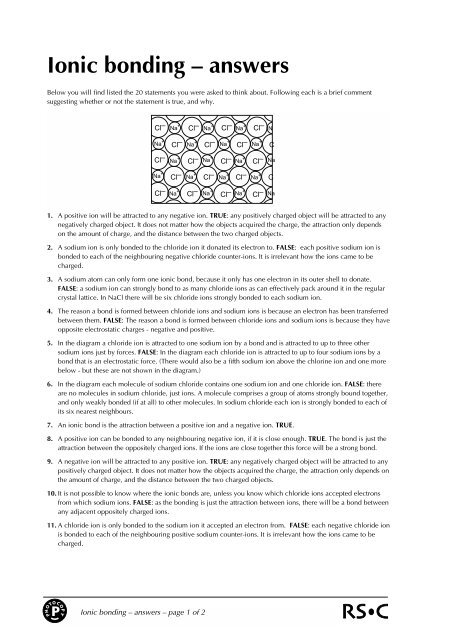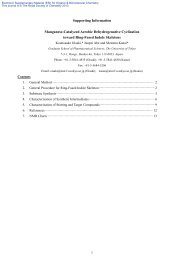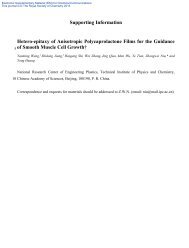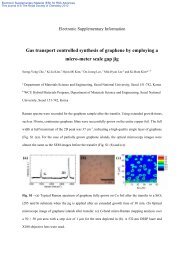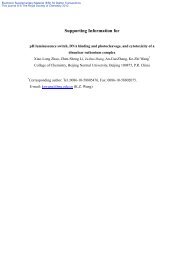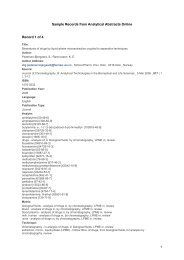Ionic bonding â answers
Ionic bonding â answers
Ionic bonding â answers
You also want an ePaper? Increase the reach of your titles
YUMPU automatically turns print PDFs into web optimized ePapers that Google loves.
<strong>Ionic</strong> <strong>bonding</strong> – <strong>answers</strong><br />
Below you will find listed the 20 statements you were asked to think about. Following each is a brief comment<br />
suggesting whether or not the statement is true, and why.<br />
Cl – Na + Cl – Na + Cl – Na + Cl – N<br />
Na + Cl – Na + Cl – Na +<br />
Cl – Na +<br />
C<br />
Cl – Na + Cl – Na +<br />
Cl – Na + Cl – Na<br />
Cl – Na + Cl – Na + Cl – Na + C<br />
Cl – Na + Cl – Na +<br />
Cl – Na +<br />
Cl – Na<br />
Na +<br />
1. A positive ion will be attracted to any negative ion. TRUE: any positively charged object will be attracted to any<br />
negatively charged object. It does not matter how the objects acquired the charge, the attraction only depends<br />
on the amount of charge, and the distance between the two charged objects.<br />
2. A sodium ion is only bonded to the chloride ion it donated its electron to. FALSE: each positive sodium ion is<br />
bonded to each of the neighbouring negative chloride counter-ions. It is irrelevant how the ions came to be<br />
charged.<br />
3. A sodium atom can only form one ionic bond, because it only has one electron in its outer shell to donate.<br />
FALSE: a sodium ion can strongly bond to as many chloride ions as can effectively pack around it in the regular<br />
crystal lattice. In NaCl there will be six chloride ions strongly bonded to each sodium ion.<br />
4. The reason a bond is formed between chloride ions and sodium ions is because an electron has been transferred<br />
between them. FALSE: The reason a bond is formed between chloride ions and sodium ions is because they have<br />
opposite electrostatic charges - negative and positive.<br />
5. In the diagram a chloride ion is attracted to one sodium ion by a bond and is attracted to up to three other<br />
sodium ions just by forces. FALSE: In the diagram each chloride ion is attracted to up to four sodium ions by a<br />
bond that is an electrostatic force. (There would also be a fifth sodium ion above the chlorine ion and one more<br />
below - but these are not shown in the diagram.)<br />
6. In the diagram each molecule of sodium chloride contains one sodium ion and one chloride ion. FALSE: there<br />
are no molecules in sodium chloride, just ions. A molecule comprises a group of atoms strongly bound together,<br />
and only weakly bonded (if at all) to other molecules. In sodium chloride each ion is strongly bonded to each of<br />
its six nearest neighbours.<br />
7. An ionic bond is the attraction between a positive ion and a negative ion. TRUE.<br />
8. A positive ion can be bonded to any neighbouring negative ion, if it is close enough. TRUE. The bond is just the<br />
attraction between the oppositely charged ions. If the ions are close together this force will be a strong bond.<br />
9. A negative ion will be attracted to any positive ion. TRUE: any negatively charged object will be attracted to any<br />
positively charged object. It does not matter how the objects acquired the charge, the attraction only depends on<br />
the amount of charge, and the distance between the two charged objects.<br />
10. It is not possible to know where the ionic bonds are, unless you know which chloride ions accepted electrons<br />
from which sodium ions. FALSE: as the <strong>bonding</strong> is just the attraction between ions, there will be a bond between<br />
any adjacent oppositely charged ions.<br />
11. A chloride ion is only bonded to the sodium ion it accepted an electron from. FALSE: each negative chloride ion<br />
is bonded to each of the neighbouring positive sodium counter-ions. It is irrelevant how the ions came to be<br />
charged.<br />
P <strong>Ionic</strong> <strong>bonding</strong> – <strong>answers</strong> – page 1 of 2<br />
PHOTOCOPY
12. A chlorine atom can only form one strong ionic bond, because it can only accept one more electron into its<br />
outer shell. FALSE: a chloride ion can strongly bond to as many sodium ions as can effectively pack around it in<br />
the regular crystal lattice. In NaCl there will be six sodium ions strongly bonded to each chloride ion.<br />
13. There is a bond between the ions in each molecule, but no bonds between the molecules. FALSE: there are no<br />
molecules in sodium chloride, but a continuous network of bonds throughout the lattice.<br />
14. A negative ion can only be attracted to one positive ion. FALSE: there is no limit to the number of positive ions<br />
that a negative ion can be attracted to (although there is a limit to how many can cluster around it).<br />
15. The reason a bond is formed between chloride ions and sodium ions is because they have opposite charges.<br />
TRUE: the opposite charges attract them together, and this force of attraction is the ionic bond.<br />
16. In the diagram a sodium ion is attracted to one chloride ion by a bond and is attracted to three other chloride<br />
ions just by forces. FALSE: In the diagram each sodium ion is attracted to up to four chloride ions by a bond that<br />
is an electrostatic force. (There would also be a fifth chloride ion above the sodium ion and one more (a sixth)<br />
below - but these are not shown in the diagram.)<br />
17. A positive ion can only be attracted to one negative ion. FALSE: there is no limit to the number of positive ions<br />
that a negative ion can be attracted to (although there is a limit to how many can cluster around it).<br />
18. An ionic bond is when one atom donates an electron to another atom, so that they both have full outer shells.<br />
FALSE: an ionic bond is the electrostatic force which holds two oppositely charged ions together. The ions could<br />
have become charged by electron transfer, but usually the ions were charged long before they came into<br />
contact. The bond is no stronger in the few cases where an electron has transferred between two atoms to give<br />
the ions that have become bonded.<br />
19. A negative ion can be bonded to any neighbouring positive ion, if it is close enough. TRUE. The bond is just the<br />
attraction between the oppositely charged ions. If the ions are close together this force will be a strong bond.<br />
20. There are no molecules shown in the diagram. TRUE: A molecule comprises a group atoms strongly bound<br />
together, and only weakly bonded (if at all) to other molecules. In sodium chloride each ion is strongly bonded<br />
to each of its six nearest neighbours.<br />
<strong>Ionic</strong> <strong>bonding</strong> – <strong>answers</strong> – page 2 of 2<br />
P<br />
PHOTOCOPY
<strong>Ionic</strong> <strong>bonding</strong> – true or false?<br />
The statements below refer to the diagram of the structure of sodium chloride. The diagram shows part of a slice<br />
through the three dimensional crystal structure.<br />
Cl – Na + Cl – Na + Cl – Na + Cl – N<br />
Na + Cl – Na + Cl – Na +<br />
Cl – Na +<br />
C<br />
Cl – Na + Cl – Na +<br />
Cl – Na + Cl – Na<br />
Cl – Na + Cl – Na + Cl – Na + C<br />
Cl – Na + Cl – Na +<br />
Cl – Na +<br />
Cl – Na<br />
Na +<br />
Please read each statement carefully, and decide whether it is correct or not.<br />
1. A positive ion will be attracted to any negative ion.<br />
2. A sodium ion is only bonded to the chloride ion it donated its electron to.<br />
3. A sodium atom can only form one ionic bond, because it only has one electron in its outer shell to donate.<br />
4. The reason a bond is formed between chloride ions and sodium ions is because an electron has been transferred<br />
between them.<br />
5. In the diagram a chloride ion is attracted to one sodium ion by a bond and is attracted to other sodium ions just<br />
by forces.<br />
6. In the diagram each molecule of sodium chloride contains one sodium ion and one chloride ion.<br />
7. An ionic bond is the attraction between a positive ion and a negative ion.<br />
8. A positive ion can be bonded to any neighbouring negative ions, if it is close enough.<br />
9. A negative ion can be attracted to any positive ion.<br />
10. It is not possible to point to where the ionic bonds are, unless you know which chloride ions accepted electrons<br />
from which sodium ions.<br />
11. A chloride ion is only bonded to the sodium ion it accepted an electron from.<br />
12. A chlorine atom can only form one ionic bond, because it can only accept one more electron into its outer shell.<br />
13. There is a bond between the ions in each molecule, but no bonds between the molecules.<br />
14. A negative ion can only be attracted to one positive ion.<br />
15. The reason a bond is formed between chloride ions and sodium ions is because they have opposite charges.<br />
16. In the diagram a sodium ion is attracted to one chloride ion by a bond and is attracted to other chloride ions just<br />
by forces.<br />
17. A positive ion can only be attracted to one negative ion.<br />
18. An ionic bond is when one atom donates an electron to another atom, so that they both have full outer shells.<br />
19. A negative ion can be bonded to any neighbouring positive ions if it is close enough.<br />
20. There are no molecules shown in the diagram.<br />
P<br />
PHOTOCOPY<br />
<strong>Ionic</strong> <strong>bonding</strong> – page 1 of 3
True or false? –<br />
response sheet<br />
1. True False 1.<br />
2. True False 2.<br />
3. True False 3.<br />
4. True False 4.<br />
5. True False 5.<br />
6. True False 6.<br />
7. True False 7.<br />
8. True False 8.<br />
9. True False 9.<br />
10. True False 10.<br />
11. True False 11.<br />
12. True False 12.<br />
13. True False 13.<br />
14. True False 14.<br />
15. True False 15.<br />
16. True False 16.<br />
17. True False 17.<br />
18. True False 18.<br />
19. True False 19.<br />
20. True False 20.<br />
<strong>Ionic</strong> <strong>bonding</strong> – page 2 of 3<br />
P<br />
PHOTOCOPY
True or false? –<br />
response sheet<br />
1. True Do not know False 1.<br />
2. True Do not know False 2.<br />
3. True Do not know False 3.<br />
4. True Do not know False 4.<br />
5. True Do not know False 5.<br />
6. True Do not know False 6.<br />
7. True Do not know False 7.<br />
8. True Do not know False 8.<br />
9. True Do not know False 9.<br />
10. True Do not know False 10.<br />
11. True Do not know False 11.<br />
12. True Do not know False 12.<br />
13. True Do not know False 13.<br />
14. True Do not know False 14.<br />
15. True Do not know False 15.<br />
16. True Do not know False 16.<br />
17. True Do not know False 17.<br />
18. True Do not know False 18.<br />
19. True Do not know False 19.<br />
20. True Do not know False 20.<br />
P<br />
PHOTOCOPY<br />
<strong>Ionic</strong> <strong>bonding</strong> – page 3 of 3


